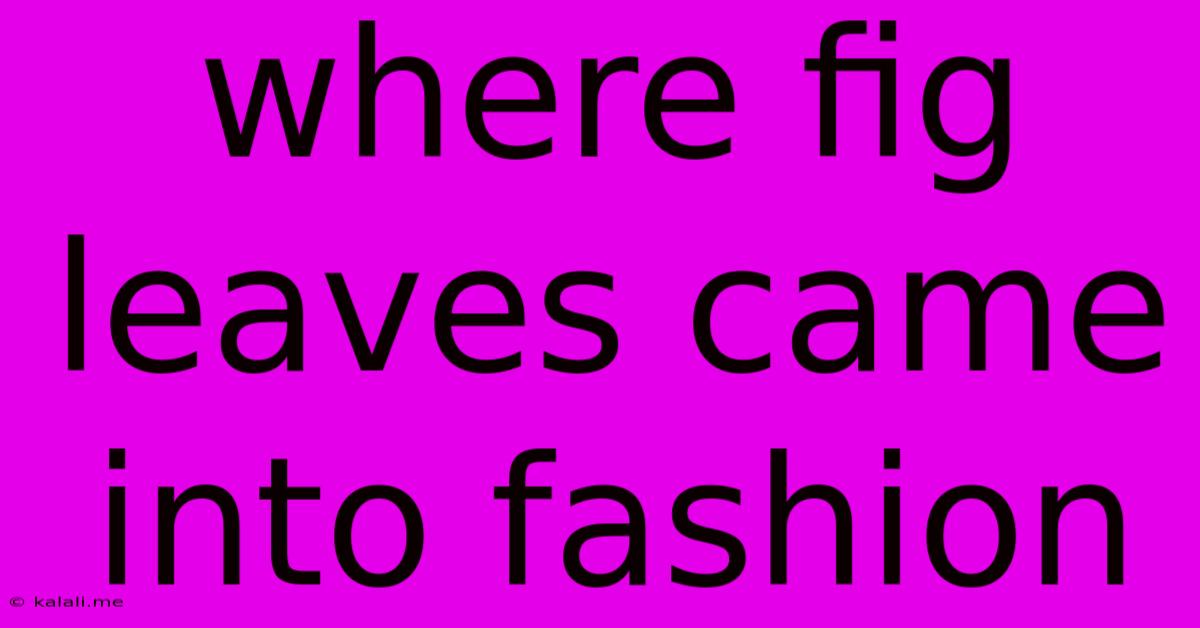Where Fig Leaves Came Into Fashion
Kalali
May 23, 2025 · 3 min read

Table of Contents
Where Fig Leaves Came Into Fashion: A Surprisingly Complex History
The image of Adam and Eve covering their nakedness with fig leaves is iconic, deeply ingrained in our collective consciousness. But did this biblical imagery directly lead to fig leaves becoming a fashion statement? The answer, surprisingly, is complex and nuanced, far removed from a simple "cause and effect" relationship. This article delves into the history of fig leaves in fashion, exploring their symbolic significance and their actual use throughout time.
While the Bible’s portrayal of fig leaves as rudimentary clothing is impactful, there's no direct evidence suggesting it sparked a widespread fig leaf fashion trend. The use of fig leaves wasn't a fashion choice in the sense we understand it today. Instead, its presence in religious art and literature points to a deeper symbolic meaning, representing modesty, innocence, and the fall from grace.
The Symbolic Power of Fig Leaves in Art and Literature
For centuries, artists and writers used fig leaves to represent both the loss of innocence and the attempt to regain it. This symbolic usage permeated various cultures and artistic movements. In Renaissance paintings, for instance, fig leaves frequently appear to strategically conceal the nudity of classical figures, reflecting the prevailing social norms of modesty. It wasn’t about actual fig leaf clothing, but rather a visual representation of covering up something considered inappropriate for public display.
This symbolic use continued into later periods, albeit with varying interpretations. The Romantic movement, for example, might have employed fig leaves with a sense of melancholy and longing for a lost paradise, reflecting a different understanding of the biblical narrative.
Fig Leaves in Actual Garments: A Rare Occurrence
While the fig leaf holds powerful symbolic weight, its use in practical clothing is far less common throughout history. The leaves themselves are unsuitable for clothing due to their fragility and rapid decay. Any instances of using actual fig leaves for clothing would have been extremely localized and temporary, perhaps for ceremonial purposes or in desperate survival situations.
What's more likely is that fig leaves served as a visual metaphor for clothing in artistic representations. Artists used them as a convenient and readily understood symbol to avoid depicting explicit nudity.
The Modern Resurgence: A Niche Trend
In modern times, fig leaves have seen a minor resurgence, primarily in niche artistic and theatrical contexts. They might appear in avant-garde fashion or performance art, often serving as a commentary on body image, societal norms, or the very concept of modesty itself. However, this is a very different context than historical use, devoid of the biblical or classical symbolism.
The use of fig leaves in modern fashion is highly contextual and doesn't represent a widespread adoption of fig leaves as everyday attire. It’s typically seen as a provocative or conceptual element rather than a practical one.
Conclusion: Symbolism over Substance
In conclusion, the notion of fig leaves "coming into fashion" is misleading. Their presence in art and literature is primarily symbolic, representing themes of innocence, shame, and the attempt to conceal nudity. While actual fig leaf clothing might have existed in rare, localized contexts, it never became a mainstream fashion trend. The enduring power of the fig leaf lies not in its practicality as clothing, but in its rich symbolic weight within religious, artistic, and literary traditions. It's a powerful image that continues to resonate and inspire interpretations across time and cultures.
Latest Posts
Latest Posts
-
How Does A Flame Sensor Work
May 23, 2025
-
Parry 5e Can You Choose What Damage You Reduce
May 23, 2025
-
How Do I Trap Elijah In The Vault
May 23, 2025
-
Divergence Theorem For A Scalar Field
May 23, 2025
-
Is Cold Pizza Bad For You
May 23, 2025
Related Post
Thank you for visiting our website which covers about Where Fig Leaves Came Into Fashion . We hope the information provided has been useful to you. Feel free to contact us if you have any questions or need further assistance. See you next time and don't miss to bookmark.